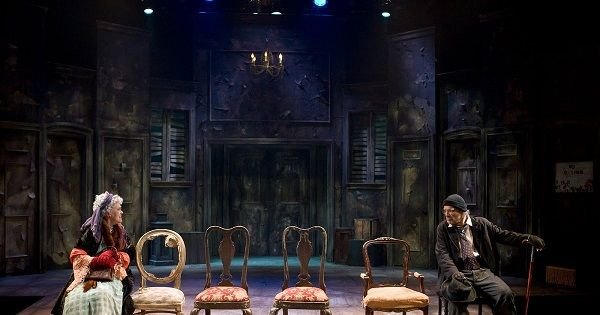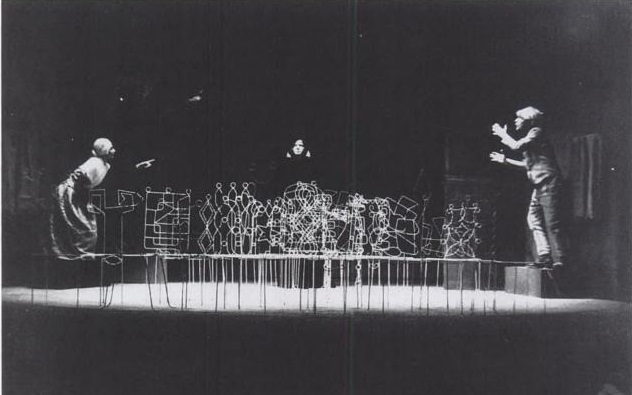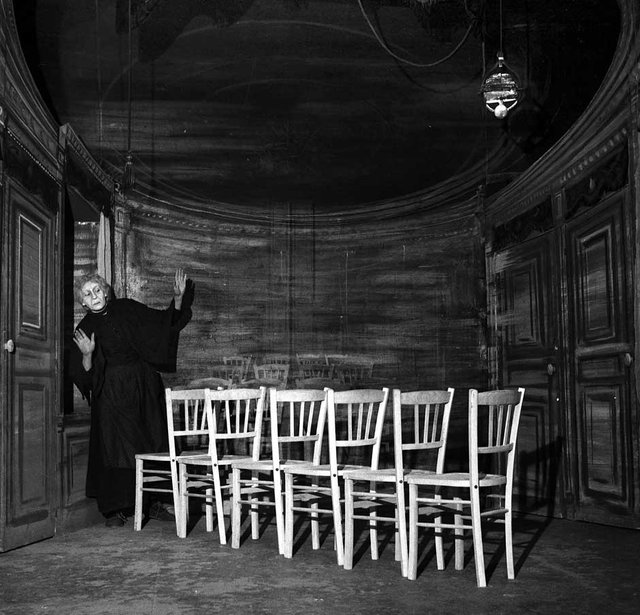Theater of the Absurd and the play "The Chairs" by Eugene Ionesco

"The Chairs", Deborah Strang / Geoff Elliott. Photo by Craig Schawartz
In the theater of absurdity, the ego is problematic not in the direction of the past, as in the psychological modern drama (Chekhov), but in the direction of itself. The absurd drama is formulated around the paradox where two answers are possible. One is the absurd silence, the other is an empty talk. In absurd drama, the very logical structures of speech are now negated - meaningless, whereas in Chekhov they still exist, even though the first beginnings of total decline are noticed.
Ionesco feels it is unacceptable for his plays to be analyzed and to tear down their integrity at the expense of rational truths. From mystics, we know that all the miracles that exist in the darkness of the unconscious and are taken out in the daylight of reason will become a cartoon image. Ionesco's plays are irrational in nature, and he is against any attempt at clarification or interpretation that attempts to close it in a foreign and distorted world. "Once the world is unable to understand me, I'm waiting for someone to explain me," words about the initial failure of the Chairs.
In "The Chairs," it's about an old-grown couple that ends up in the loneliness of an isolated island of the rest of their days. The life of both of them has gone into a sad reconciliation with the failure of hopes and ambitions, in vain anticipation of the avoided happiness. The old man has been called a great man, but he has not been able to become anything more than a janitor. This motif with its dream and its collision with the disappointing reality we observe in Chekhov's Three Sisters. In the event presented by the "Chairs", however, the Old Man invited a solemn reception in his home of leading figures to convey to them, and through them and to all mankind, his spiritual covenant, his "message", the insights of his life experience. The two elderly are in tense expectation. Ringing at the entrance tells that invisible guests are arriving. Only by the reactions of the Old Man and the Old Man we can understand that their guests are there. There is an impression of the imaginary presence of a noisy and brilliant secular crowd, totally opposed to their isolation.
This storyline makes the "Chairs" a play about the failed life of the two elders or a broader understanding - a play about failure at all, the absurd, the futility of existence. The play is titled "Chairs" and what she wants to express is related not to the event that is played and seen with my eyes but to the view of the many empty chairs that are her true heroes. This emptiness, the sense of nothingness, is the suggestion that Ionesco seeks to achieve with this metaphor. For the "Chairs," Ionesco commented that he just had the idea of an empty room that would be filled with unoccupied chairs. The chairs that came at full speed and faster, constituted the central picture, for me it was the ontological emptiness, a kind of whirlpool of the empty. On this initial idea, this first intrusive idea imbued a story, that of the two old men who are on the brink of nothingness, who have had trouble all their lives. But their story is only designed to maintain the initial, basic picture that gives meaning to the play.
The theater of absurd is a reflection of the author's personal world, he is deprived of objectively credible characters, and it is also radically apolitical, unlike the theater of existentialism. The aesthetic concept of absurdity is based on the idea of alienation, the inability of man to establish real contact with his or herself and the world and lead to their deprivation, their inability to react in their own name.

The play "The Chairs" by Eugene Ionesco
The old man and the old woman have a human face but are emptied of real human content. They are not personalities for whom we construct an image of their behavior. They do not have their own will. The alienation has deprived them from within, and the effect of this inner void is the destruction of their relationship with the outside world. The reactions of the old man and the old woman are mechanical, deprived of the thrill of life. Behind them is not a real person. There is no causal relationship between them.
One of the major consequences of turning the play into a reflection of the author's subjective world affects the plot. Like the images that have distorted the likeness of personalities, the plot is altered by the classic notion. Ideally, a dramatic production that expresses intuition in depth should evolve in a single moment only because it is materially impossible to present such a complex vision in one moment it extends over a certain amount of time Or else at least the theoretical drama of the absurd can not have a plot. Eternity enters the clash with the transient.
The moment stretches, this removes the barrier of time. This allows an instant vision to be expressed in a series of pictures that in their entirety produce a profound experience of this subtle moment.
For a brief explanation, this is not a trend only in absurdity, the stretching of the moment can also be seen in the poetic world and other arts. Some philosophers of intuition also build their systems on the original vision, and they are just pale reflections of this first experience.
As an example, I can give the philosophy of Schopenhauer, which is said to be built on a terrible and gloomy nightmare, and then his philosophy was just a remnant of this experience, a pale attempt to be exposed in theory.
Theater,declares Ionesco, may very well be the only place where nothing really happens. The privileged place where nothing would happen. The plot serves to keep the illusion that something is happening on the scene, and nothing really happens.

A performance of Eugene Ionesco’s Chairs, Paris, February 1956
The true purpose of the story is to provide the steps to reach the touch with the emotional layer. At the end of his movement, we find ourselves in front of the main picture in its pure, static look - the deserted scene with no chairs, the wide open door to the dark, and the wind-curved curtains of the windows. In front of the painting, the emptiness, the "total absence" of nothing. The two elders and the speaker were only meant to prepare this moment.
The play "Chairs" in the words of Ionesco represents "just a sequence without sequence, a casual chain without a specific causal link, unexplained adventures or emotional states, or indescribable but living tangles, intentions, passions without unity, sinking into contradictions." That is why the "Chairs" are difficult to read. But even if the story of Chairs is redefined, its storyline will not give us the content of the emotional layer hidden under its shell. The experience of the old man and the old woman, taken for themselves, does not imply the sense of hopelessness that implies the play. From the plot we can not "sense" the play, because its factual content is embedded not in the meaning and sequence of events but in the emotional emanation of the combination of these events. That is why Ionesco is indignant at the critic's attempt to label him. The story itself does not make sense, he says nothing. As Ionesco points out: "The whole intrigue, the whole private action is not of interest.
It can only be an accessory, it should be only drainage of a dramatic tension, its support, its steps, its stages. The release of dramatic tension must be achieved without the help of any real intrigue, to any private purpose.
Ionesco's skills are deprived of the ability to reason. At Beckett, the characters speak for not to think. For example, Pozzo / Waiting for Godo / who, when he takes off his hat, pours a river of madness without actually saying anything. In Beckett, unlike Ionesco, the expressed feeling is expressed in the situation. The story of Ionesco's plays is composed "singularly" - the goal is to reach the point where the final metaphor is. In Beckett's plays, however, the storyline can not come out of the situation. The plot of Beckett's play has led to a clean idling movement, to go one step. Its function is to measure the duration of the man's aimless stay in the world. As the storyline in "The Chairs"with the emblem of the emptiness, nowhere, the plot in Beckett's plays is a kind of moving background showing the immobility of the situation and the characters in it.
Unlike Surrealism and especially Dadaism, which deliberately ruin the language in a quest for shock, in anxiety to make the "absurdity of everything" or to search for a new language of super-reality, then in the "theater of absurd" the language is something different. It shows the inability to contact. In it the alienation is displayed in its finest form.
How wonderful that you wrote that post ;) I remember "The Chairs" from school it was a mandatory book. Up my friend :)
Very interesting - thank you!
You are welcome :)